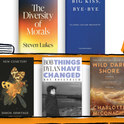This is an important and timely book. It helps both to explain aspects of current European politics—such as the rise of populism and David Cameron’s repeated appeals to British values—and also provides a rigorous guide to what majorities can and cannot do to preserve their culture and way of life.
Its author, Liav Orgad, an Israeli lawyer, circles his subject with more legalistic detail than most people will comfortably bear. But it is an intellectual ice-breaker and will, or should, open up new territory for others to explore.
The idea of majority rights seems like a contradiction in terms. Majorities, it has been assumed, do not need special legal protection because their culture is dominant and transmitted through everything from schools to national ceremonies. And majorities by definition carry the greatest weight in a democracy, including deciding (at least in theory) the terms on which others can join the society.
And yet it has always been one of the blind spots of multiculturalism and theories of minority rights that they have had so little to say about ethnic majorities. Eric Kaufmann is one of the few academics to write interestingly about multiculturalism’s “asymmetry”—its stress on the importance of personal autonomy, cultural preservation and group identity for individuals from minorities but its failure to see that the same principles, and psychological needs, might apply to individuals from majorities, too.
This was noticed by the British National Party and others on the far right who cynically invoked multiculturalism to defend whites in areas of rapid ethnic change. Meanwhile Donald Trump’s appeal in the United States is surely based in part on the demographic anxiety of lower-status whites—non-Hispanic whites are now just 60 per cent of the US population—the sort of people who, in David Frum’s description, are irked to have to “press one for English” on automated phone systems.
“We got nothing but problems… We’re dying. We’re dying,” declared Trump in a recent speech. He is right. A celebrated paper by Angus Deaton and Anne Case has established that middle-aged white Americans, especially those without a college degree, are actually dying prematurely in very high numbers, mainly from suicide, alcoholism and overdoses of prescription and illegal drugs, because they think there is no future for people like them.
So are national majorities really now under such pressure that they need new legal and political assistance? Orgad is not completely comfortable with the idea, but ends up justifying support for a “thin” version of the majority culture, partly on the grounds of avoiding a nationalist backlash.
He describes four kinds of “needy” majorities who might be justified in claiming some kind of protection. First, and most relevant to contemporary Europe, are the majorities slowly disappearing in the light of low fertility and immigration. Second are regional-minority majorities such as the non-Russian majorities in the Baltic states and Ukraine, which face a permanent threat of Russian domination. Third are victimised majorities, such as the Jews in Israel, who as a result of past persecution and scattering feel entitled to only allow immigration from fellow Jews. And finally, “minoritised majorities” such as the Slovak majority in Slovakia, who behave towards the Hungarian minority with the state of mind of a minority because the Slovaks were once subordinate to the Hungarians in the Austro-Hungarian empire.
Focusing on disappearing majorities in western countries, Orgad also describes the diverging lifestyles and values of majorities and minorities—at least when the latter come from traditional cultures—on gender equality, free speech, sexual openness, religious piety and so on. Paradoxically, liberalism makes this divergence more, not less, likely: human rights law, multiculturalism, group rights and welfare states, when combined with the sheer scale of recent immigration, make it easier for minorities not to absorb majority norms and to live parallel lives.
So if we accept that majorities do have some right to exist on grounds of personal autonomy and identity (in the same way that minorities do), then what can they require of minorities to ensure that continued existence? Rather disappointingly, Orgad’s answer focuses very narrowly on immigration and naturalisation rules: citizenship and language tests, loyalty oaths, integration contracts and so on.
This is certainly one part of the story, and in Europe these admission criteria—commonplace for decades in the US, Canada and other immigration-based western countries—have emerged from nothing 15 years ago into a thicket of exams and tests.
He compares the tests as they apply to Europe, the US and Israel, and within Europe he considers France, Germany, the Netherlands and the UK. And he is sniffily censorious about almost anything that departs from liberal democratic generalities.
Orgad is right that some of the test questions are a bit crass. In the 2005 UK citizenship test, people had to “know” whether Father Christmas came from Iceland, Lapland or the North Pole.
And he is also right that such tests often imply a falsely static and singular view of being British or German or Dutch. But he seems to forget that these are just one-off entry tests and have a mainly symbolic value for both new and existing citizens. It does not matter where Father Christmas comes from. What does matter is that you have made the effort to read and remember the Life in the UK guide to passing the citizenship test, and thereby acknowledged that you are entering an already existing society with its own rules and idiosyncrasies.
"The forces that make integrating minorities harder—liberalism, multiculturalism, identity politics—also fragment the majority"
Orgad reserves his greatest scorn for the Dutch test, which subjects applicants to pictures of nude women and homosexuals. Yet even this test, as he admits, accepts the principle that you do not have to be a liberal to become a member of a liberal society. You can remain privately disapproving of homosexuality, but you do have to accept the right of other Dutch people to display their homosexuality in public.
To look at it the other way round, a liberal state can prioritise the way of life of the majority, but must also accept other ways of life (within the law). That is fine so far as it goes but it leaves open the question of what is a majority? And how, beyond the design of one-off citizenship tests, can a majority way of life be prioritised in the hurly-burly of everyday life?
Orgad simply assumes there is such a thing as a coherent majority by which he seems to mean an ethno-cultural majority. But does it even make sense to talk of a dominant culture or a national way of life in modern Britain? The forces that make integrating minorities harder—liberalism, multiculturalism, identity politics and so on—also increasingly fragment the majority. Think of the gulf between a Ukip sympathising 65-year-old grandmother living in a small town in the north of England and a Guardian-reading gay web designer living in Hoxton. We have always been a country of many tribes but do we still recognise something in common behind our particularist colourings?
It seems that many of us do. We no longer think ethnically, except in the haziest of ways, and we would be horrified if David Cameron started talking about promoting white British values. Yet it is, of course, a society not an ethnicity that we want newcomers to respect and join, albeit a society shaped historically by the ethnic majority.
And it is in that surrounding society where the majority way of life, in all its variety, can still be found—from the Queen at the top to neighbourhood shops at the bottom.
Orgad does not seem to be interested in preserving a majority culture in everyday life. But this is surely the crux of the matter. There may be no right to remain the majority in your own neighbourhood (if you are from the ethnic majority) but there is some implicit political right to a settled cultural life, to some control over and stability in your surroundings. This is the social psychological basis of minority and majority identity rights.
And it means broadening the focus of a liberal theory of majority rights to include, among other things, protecting the role of the majority language, parliamentary sovereignty, history in schools, national rituals (it is no coincidence that Remembrance Day becomes more, not less, important every year) and encouraging an ethnic mix in schools and neighbourhoods that reflects the national demography and that all groups are broadly comfortable with.
Not all these things are easily subject to legislation, but there are other ways of promoting desirable things than through law. Well-designed “nudges” may be more effective than legislation in encouraging people to think of people from other religious or ethnic groups as potential friends.
Towards the end of the book, Orgad raises the interesting question of whether the quest for majority rights is a “swan song” for an old idea of national identity. Perhaps as people become more educated and mobile, they will draw their identities less from place and group and more from inside themselves, making them less concerned with maintaining stable communities. I doubt it.
But if ethnic majorities are destined to become minorities throughout the west, we are left with another question: is it possible to retain a strong sense of public interest and mutual regard in a society that is not grounded in an ethnic majority? Over the next 50 years we will find out.












